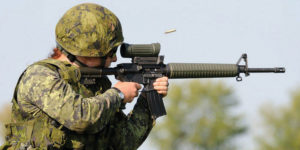By Steve Fouchard
Valcartier, Que.— Defence Research and Development Canada (DRDC), the research agency of the Department of National Defence, has begun the Future Small Arms Research (FSAR) project, a scientific evaluation of current technologies to ensure the Canadian Army (CA)’s small arms of tomorrow will meet all of its operational needs.
The CA, through its Directorate of Land Requirements, is in the process of replacing or modernizing its small arms and associated munition and fire control systems. In the last decade, great advances have occurred in materials, electronics, optics and computing. These technologies are making their way into new weapons and DRDC is currently engaged through FSAR to guide the Army’s acquisition of future soldier-carried assault weapon systems.
Dr. Franklin Wong, a researcher at DRDC’s Valcartier Research Center, leads the project with the cooperation of the Toronto Research Center. He explained that one of the key project objectives is to provide advice, using experimental data and analysis, on rifle designs and accessories such as rifle sights. For example, an ideal combat rifle sight would provide maximized shot accuracy and reduced time needed to identify and engage targets, while being compact enough not to limit soldiers’ mobility.
The CA’s current rifle of choice, the C7A2, is an example of a conventional weapon design that has its magazine located in front of the pistol grip. This design has implications on the overall weapon length and accuracy and ease of access to weapon controls. FSAR is assessing the performance of conventional designs built with more recent technology as well assessing the alternative weapon design known as the ‘bullpup’ layout. Developed in the 1950s, the bullpup configuration has the magazine behind the grip, which may have some advantages.
“The accuracy of a weapon is dependent on the length of the barrel,” Dr. Wong said. “When you go to a bullpup design, because you move the magazine behind the pistol grip, you can move the chamber of the barrel back where the magazine is. The overall length of the rifle is shorter, however, the length of the barrel can remain long for accuracy purposes.”
Dr. Wong continued, “So it [bullpup layout] attempts to address the mobility versus accuracy issue. You have a shorter weapon and it should help you move through tight spaces that much easier. The question is, can the person shoot more accurately with it? And can they shoot more quickly? The FSAR team examined these human factor questions in a field trial involving troops from the Princess Patricia’s Canadian Light Infantry Regiment in Edmonton.”
Accuracy is dependent upon other factors as well, Dr. Wong explained. While training certainly has an important role to play, so do design and optical technologies.
“The bullet has to achieve a certain stability as it leaves the barrel so that it flies straight,” he explained. “Shooting a bullet is sort of like an internal combustion engine. There’s a big explosion with a flow of hot gasses. Every time you shoot a round it’s like hitting the barrel with a hammer with each explosion. That’s where inaccuracies come in. Say you shoot a round once and the barrel deflects off to the left and you shoot it a second time and it goes to the right. And another time it goes up and then goes down,” he noted.
“It’s very hard to predict where your bullets are going to go if your barrel, due to the material used and the mechanical design, is always changing where it’s deflecting. One of the goals for our weapon studies is to understand what materials and mechanical designs give consistent barrel dynamics,” he concluded.
Combat sights allow shooters to compensate if the barrel deflection behaviour remains consistent, Dr. Wong added, in addition to allowing the user to more quickly identify and engage targets. These sights fall into one of two categories: direct optics and electro-optics.
“Direct optics is really like a telescope,” he explained. “It’s just pieces of glass put together in a tube with no electronics in it. Electro-optical sights are like your camera. You have an electronic sensor that captures light and then that information gets displayed on a screen.”
While direct optic sights can improve reaction time in daytime conditions by providing clear, bright images, electro-optical models may have even greater potential.
“Once you have a digital image, this is where you can bring in visible and thermal cameras with image processing and then have algorithms that will help, for example, fuse the images from the visible and thermal cameras or automatically detect threats,” said Dr. Wong. “And then once, for example, an algorithm has detected a threat, it will present that information along with a fused image in some form to the soldier on a micro display. So we see that there are potential gains to be made in the reduction of time needed to detect, recognize and identify threats with this technology.”
FSAR commenced in April 2014. DRDC has been providing reports to the CA for each fiscal year of the project and will continue to do so until it concludes in March 2019. Ultimately, Dr. Wong noted, the research will not only help the CA make well-informed choices but also ensure the process is as smooth as possible for manufacturers wishing to bid on the procurement program.
“When it comes to bid evaluations, our characterization methods are key because we need to inform industry how any candidate pieces of equipment are going to be evaluated when it comes to the procurement process,” he said. “Then everybody is clear about what is going to happen and the soldiers will ultimately get the equipment they need in a timely manner.”
Steve Fouchard, is with the Army Public Affairs. He is a regular contributor to the Vanguard Magazine
